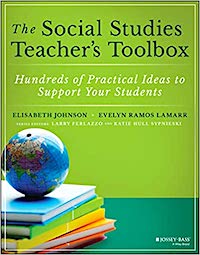This Social Studies Compendium Is a Keeper
The Social Studies Teacher’s Toolbox: Hundreds of Practical Ideas to Support Your Students
By Elisabeth Johnson and Evelyn Ramos Lamarr; series editors Larry Ferlazzo and Katie Hull Sypnieski
(Wiley/Jossey-Bass, 2020 – Learn more)

It’s a little strange for me to say this, having written two books of my own about history pedagogy. But if you’re going to buy only one book about teaching social studies, The Social Studies Teacher’s Toolbox should be it.
Elisabeth Johnson and Evelyn Ramos Lamarr, experienced teachers at the same Sacramento high school, have constructed a research-based, honest, human guide to helping our students in grades 6-12 understand, remember and care about what they learn.

The series editors, Larry Ferlazzo and Katie Hull Sypnieski, are veteran teachers and writers themselves. Johnson and Lamarr call out Ferlazzo’s prolific blog in the introduction, “due to its overall comprehensiveness” – very much like this book.
With these four savvy educators at the helm, you will dig through and dog-ear this compendium as if you’re eating a 21-course meal, and your students will be the richer for it.
Equipping Teachers With Everything They Need
The book is divided into four parts, each with highly detailed chapters:
I Reading and Writing
1. A Fresh Look at Vocabulary
2. Reading Strategies
3. Read-Aloud Protocol
4. Thematic Data Sets
5. Writing in Social Studies
6. Mnemonics
7. Timelines Revisited
8. Current Event Case Study
9. Genre Study
10. Concept Attainment
II Analysis Tools
11. Questions for Learning
12. Image Analysis
13. Analysis of Primary Sources
14. Synthesis Charts
III Speaking and Listening
15. Listening and Speaking Activities
16. Discussions
IV Additional Key Strategies
17. Project-Based Learning
18. Culturally Responsive Teaching
19. Social and Emotional Learning
20. Assessment
21. Getting the Most From Your Textbook
The chapters are all organized the same way. Each starts with a description of what the strategy is and why the authors find it useful, often referring to the higher-level thinking it encourages.
Then they list research, Common Core and social studies standards that support each topic. The research is no joke, with 25 pages of citations at the end of the book that could easily background a dissertation on teaching social studies.
Then comes application. For the Current Events Case Study chapter, this includes Sequencing of Events, Developing Questions, Bias Awareness and Research, Written Analysis, and Additional Ideas for Including Current Events in the Classroom. Each set of applications finishes with options for differentiation and advanced extensions.
All chapters also feature copious handouts, examples and figures that are ready to use. The chapter on Writing in Social Studies, for example, features a handout called Point-Example-Explain Paragraph Structure, while the Social and Emotional Learning chapter includes a Personal Empathy Map.
Finally, each chapter ends with a helpful troubleshooting segment called “What Could Go Wrong?” In the Timelines chapter, the authors suggest, “Don’t go overboard on using timelines… They can grow old and stale,” and in Discussions, “Lack of monitoring during group discussions can make small problems fester or make some students feel that the teacher does not care about their success.”
Such comments made me feel as if I was in easy conversation in the teachers’ lounge with colleagues who had already made notes for next year on what they wanted to improve.
This Book Applies to Everyone, Novice and Veteran and In Between
Even after teaching for more than two decades, I found this book invaluable in its gathering of so many classroom-tested ideas in one place. It reminded me of practices I haven’t tried for a while, such as primary source image analysis and the creation of mnemonics, and also introduced me to new ideas, such as genre study grids and concept attainment “nonexamples.”
The book also filled in some weak spots I’ve wanted to address, such as preparing students most effectively for a guest speaker (in a chapter on Listening and Speaking Activities) and setting up community circles (or restorative circles) on “provocative subjects in the curriculum like voting rights, the effects of nationalism, and the cost/benefit of war” – in an excellent chapter on Culturally Responsive Teaching.
After my one reading, The Social Studies Teacher’s Toolbox has earned a permanent place on my shelf of necessary teaching books. While planning my 8th grade U.S. history classes for the fall, I will dip into it for inspiration, and in years to come I anticipate consulting it like an encyclopedia of teaching. You’ll be missing out if you don’t do the same thing!
You can read Elisabeth Johnson and Evelyn Ramos Lamarr’s recent MiddleWeb article here.
Sarah Cooper teaches eighth-grade U.S. history and is Dean of Studies at Flintridge Preparatory School in La Canada, California, where she has also taught English Language Arts. She is the author of Making History Mine (Stenhouse, 2009) and Creating Citizens: Teaching Civics and Current Events in the History Classroom (Routledge/MiddleWeb, 2017). She presents at conferences and writes for a variety of educational sites. You can find all of Sarah’s writing at sarahjcooper.com.

































